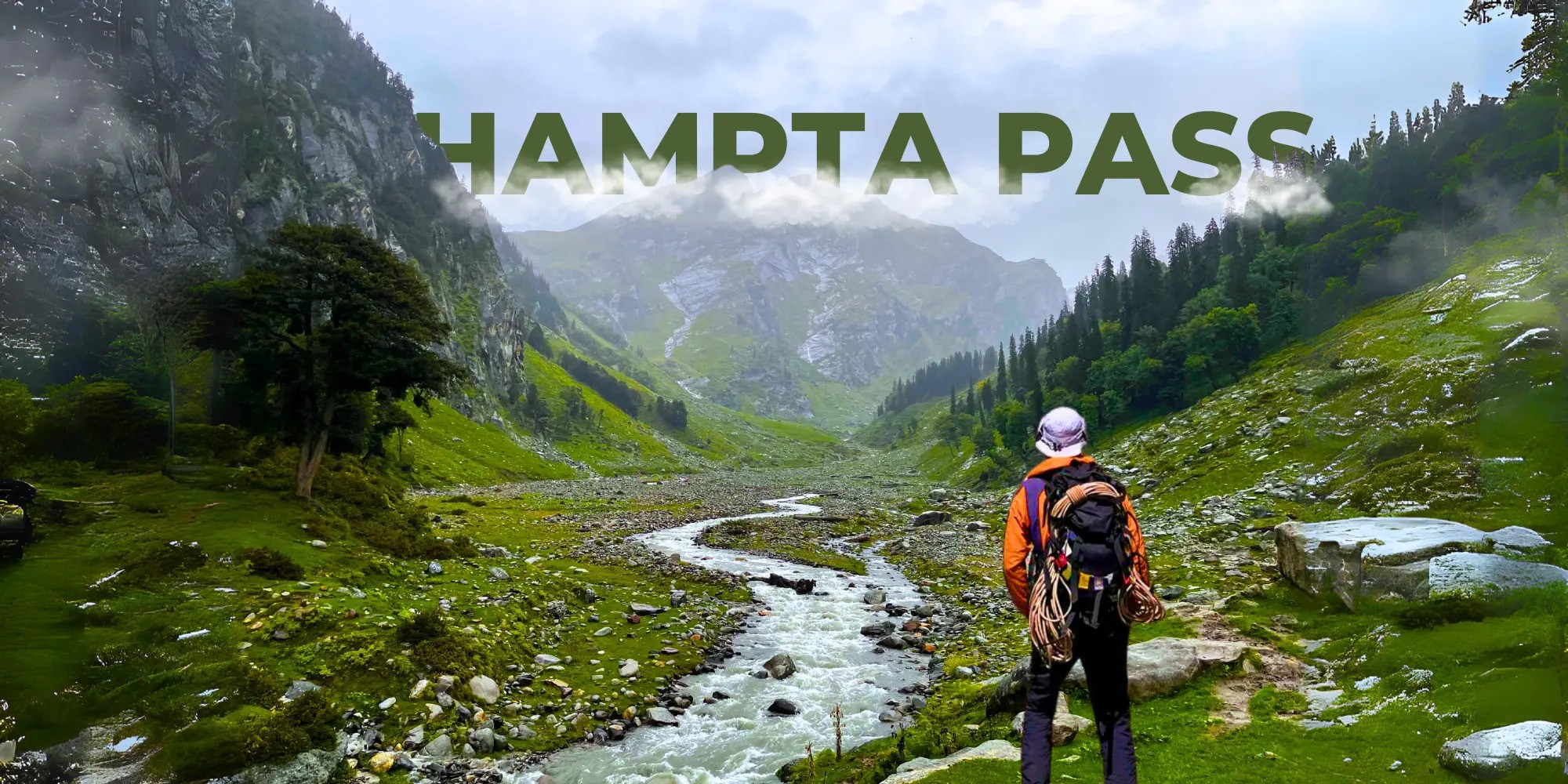Hampta Pass is a thrilling and scenic trek that takes adventure seekers through the breathtaking landscapes of the Indian Himalayas. Situated at an altitude of 4,270 meters, this pass serves as a gateway between the lush green valleys of Kullu and the rugged, arid terrain of Lahaul. The stark contrast in landscapes, coupled with the excitement of crossing high-altitude passes, makes the hampta pass trek a favorite among trekking enthusiasts.
Trekking at such elevations, however, comes with its own set of challenges. The drastic altitude gain within a short span requires trekkers to be mindful of acclimatization. A proper understanding of altitude adjustment is essential to avoid serious health risks like Acute Mountain Sickness (AMS) and ensure a smooth and enjoyable journey.
Understanding the Altitude of Hampta Pass
The Hampta Pass trek involves significant altitude variations, beginning from Manali at 2,050 meters and climbing up to 4,270 meters at the pass before descending to Chatru at 3,200 meters. Each campsite on this trek represents a different altitude level, demanding the body to constantly adjust to decreasing oxygen levels. The journey starts from Jobra at 2,900 meters, followed by a steady climb to Jwara at 3,400 meters. From there, trekkers proceed to Balu Ka Ghera, situated at 3,600 meters, before making their way to the summit of Hampta Pass. After crossing the pass, the descent begins towards Shea Goru at 3,900 meters and later to Chatru at 3,200 meters.
With such rapid elevation gain, trekkers must allow their bodies to adjust properly. The risk of altitude sickness increases when one ascends too quickly without giving the body enough time to adapt. Hence, acclimatization plays a crucial role in ensuring that trekkers complete their journey without falling ill.
Why Acclimatization is Important for the Hampta Pass Trek
As trekkers gain altitude, oxygen levels in the air decrease, making it harder for the body to function optimally. The body needs time to produce more red blood cells to compensate for the reduced oxygen supply. Without proper acclimatization, trekkers are at risk of developing altitude sickness, which can lead to severe complications if left unchecked. Symptoms of altitude sickness include headaches, nausea, dizziness, breathlessness, and loss of appetite. In more severe cases, AMS can progress to High-Altitude Pulmonary Edema (HAPE) or High-Altitude Cerebral Edema (HACE), both of which can be life-threatening.
To avoid such risks, trekkers must follow proper acclimatization techniques, maintain hydration, and listen to their bodies. It is always advisable to ascend gradually, stay hydrated, and rest adequately at each campsite before moving to a higher altitude.
Best Acclimatization Tips for the Hampta Pass Trek
Spending a day or two in Manali before starting the trek allows the body to begin the acclimatization process. Manali, at an altitude of 2,050 meters, offers a good starting point to adjust to higher elevations before moving further up. Taking short hikes in the surrounding areas can help in adapting to the thinner air.
Following the “climb high, sleep low” rule is another effective way to acclimatize. This method involves ascending to a higher altitude during the day and descending slightly before sleeping at night. Such gradual exposure allows the body to adapt to reduced oxygen levels more efficiently.
Staying hydrated is essential during high-altitude treks, as dehydration worsens altitude sickness. Trekkers should drink at least three to four liters of water daily but avoid excessive hydration, which can lead to electrolyte imbalances. A diet rich in carbohydrates provides the necessary energy to cope with the physical demands of the trek. Foods like rice, pasta, and bread help maintain endurance and stamina.
Maintaining a slow and steady pace throughout the trek prevents exhaustion and allows the body to adjust gradually. Rushing to higher altitudes increases the risk of AMS, making it crucial to walk at a comfortable pace with regular breaks. Alcohol and smoking should be avoided during the trek, as both substances reduce oxygen levels in the blood and make acclimatization more difficult.
Some trekkers opt to take Diamox, a medication that aids in acclimatization by stimulating breathing. However, it is important to consult a doctor before using it, as it may have side effects. Natural acclimatization remains the best approach to avoiding altitude sickness. Ensuring adequate rest and sleep every night is equally important, as a well-rested body adapts faster to changing altitudes.
What to Do If You Experience Altitude Sickness
Recognizing the early symptoms of AMS and taking immediate action is crucial. If mild symptoms like headaches or nausea occur, resting, hydrating, and consuming warm fluids can help. However, if symptoms persist or worsen, ascending further should be avoided, and in severe cases, descending to a lower altitude is the only solution. Ignoring the signs of altitude sickness can lead to severe complications that require emergency medical attention.
Trekkers should always inform their guide or fellow trekkers if they feel unwell. Carrying basic medicines for headaches, nausea, and dehydration can provide temporary relief, but medical intervention is necessary if symptoms do not improve.
Ideal Itinerary for Acclimatization on the Hampta Pass Trek
A well-structured itinerary is essential for effective acclimatization. The trek typically begins with a drive from Manali to Jobra, followed by a short trek to Jwara on the first day. Spending the night at Jwara allows for gradual adjustment before proceeding to Balu Ka Ghera the next day. The third day involves reaching the highest point, Hampta Pass, and descending to Shea Goru, ensuring that trekkers do not sleep at the highest altitude. On the fourth day, the trek continues to Chatru, with an optional visit to Chandratal, depending on acclimatization levels. The final day marks the return journey to Manali.
This itinerary ensures that the body has enough time to adjust at each stage, minimizing the risk of altitude sickness while allowing trekkers to enjoy the stunning landscapes.
Preparing for the Hampta Pass Trek: Essential Tips
Physical preparation plays a significant role in determining how well a trekker acclimatizes to high altitudes. A month of pre-trek training involving cardio exercises, strength training, and hiking practice helps build stamina. Packing wisely is equally important, with proper layering of clothing, waterproof jackets, and sturdy trekking shoes being essential. A good-quality sleeping bag suited for sub-zero temperatures ensures comfort during cold nights.
Trekkers should also carry basic medicines, energy bars, and hydration packs for sustained energy. Trekking poles provide additional stability, especially during steep climbs and descents. A well-prepared trekker faces fewer challenges and enjoys the journey with confidence.
Conclusion
The Hampta Pass trek is an exhilarating adventure that rewards trekkers with stunning landscapes and an unforgettable experience. However, the rapid altitude gain requires proper acclimatization to avoid altitude sickness and ensure a safe journey. By following acclimatization techniques such as gradual ascent, hydration, proper nutrition, and adequate rest, trekkers can fully enjoy this Himalayan gem without compromising their health. Preparation, awareness, and listening to one’s body are the keys to successfully completing the trek while experiencing the unparalleled beauty of the Himalayas.








